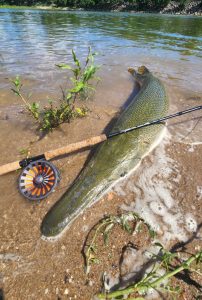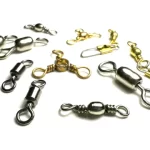Alligator gar, one of the largest freshwater fish in North America, is a bucket-list catch for many anglers. Known for their prehistoric appearance and powerful fights, these apex predators are particularly challenging yet rewarding to catch on a fly rod. Here’s how to prepare and succeed in targeting this extraordinary species.
Understanding Alligator Gar
Before setting out, it’s essential to understand the behavior and habitat of alligator gar. These fish prefer slow-moving waters, such as rivers, backwaters, and oxbow lakes. Their diet consists mainly of other fish, making them opportunistic feeders.
1. Choose the Right Gear
Catching alligator gar on a fly rod requires specialized equipment capable of handling their size and strength.
- Fly Rod: Use an 8- to 10-weight rod with a strong backbone to handle their powerful runs.
- Reel: A quality reel with a smooth drag system is essential to manage long runs.
- Fly Line: Floating lines paired with a short, heavy leader work well, especially when gar are feeding near the surface.

2. Select the Best Flies
Alligator gar are attracted to flies that mimic their natural prey. Streamer patterns, such as deceivers and large baitfish imitations, are effective.
- Material: Flies tied with synthetic materials hold up better against the gar’s sharp teeth.
- Size and Color: Brightly colored flies in sizes 4-6 inches often grab their attention. Chartreuse, white, and red are popular choices.
3. Time Your Fishing Trip
Timing plays a critical role in catching alligator gar. These fish are more active during specific conditions.
- Best Seasons: Late spring through early fall provides optimal water temperatures and feeding activity.
- Ideal Times: Early mornings and late afternoons are when gar are most likely to surface feed.
4. Spotting and Targeting Gar
Sight fishing is the most effective method for targeting alligator gar. Look for fish surfacing or basking near the water’s edge.
- Approach: Move slowly and quietly to avoid spooking the fish.
- Presentation: Cast slightly ahead of the fish and retrieve the fly with slow, erratic movements to mimic injured prey.
5. Hooking and Fighting Techniques
Hooking an alligator gar requires patience and precision due to their bony mouths.
- Set the Hook: Wait for the gar to fully take the fly before setting the hook with a strong strip strike.
- Playing the Fish: Use steady pressure and let the drag system do the work. Avoid high rod angles to prevent break-offs.
6. Safety and Conservation
Handling alligator gar properly is crucial to ensure their survival post-release.
- Use a Landing Net: A sturdy landing net helps control the fish without causing harm.
- Minimize Air Exposure: Keep the fish in the water as much as possible during unhooking and photographs.
- Barbless Hooks: Consider using barbless hooks for easier and safer releases.
Fly fishing for alligator gar is a unique challenge that tests an angler’s skill and patience. By understanding their behavior, using the right gear, and employing proper techniques, you can experience the thrill of landing one of these magnificent fish. Remember to prioritize conservation to ensure these prehistoric giants remain a part of our waterways for generations to come.
Image: riversandfeathers





